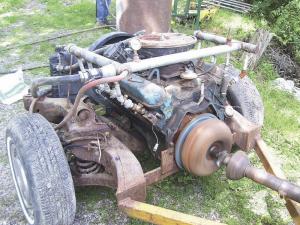2011 - Volume #35, Issue #1, Page #39
[ Sample Stories From This Issue | List of All Stories In This Issue | Print this story
| Read this issue]
Air Compressor Built From Cadillac Engine
 |
"I called Harold a couple times, and he was real helpful," says Jamison. "I pulled the engine and discarded the transmission, but kept the flexplate and torque converter. I stripped the front fenders, bumper, radiator support, etc. from the front clip and cut it free from the engine."
He made an "A" frame hitch from rectangular tubing and welded it to the front axle. He then reinstalled the engine, radiator and alternator on the trailer.
Jamison stripped the rocker arms, push rods, intake valves, exhaust manifold and carburetor from the engine. In place of the carburetor, he attached a steel plate to the intake manifold and connected it to the original air cleaner housing and filter with a short, large diameter pipe.
He left the exhaust valves in place, but he replaced the factory intake springs with light springs from a hardware store. He welded flat washers to the tops on the intake valves to act as "keepers". Once he drilled the porcelain centers out of the stock spark plugs, the four-stroke engine was effectively converted into a two-stroke compressor.
"Each downward piston move overcomes the light intake valve springs, letting air in," explains Jamison. "Each upward piston movement forces air out of the spark plug holes. A large amount of heat is produced when the air in the cylinder is forced through the spark plug hole. It's important to drill the plugs out as much as possible to reduce heat buildup."
To capture the air, Jamison welded a short piece of 3/8-in. diameter water pipe to each hollow spark plug. He mounted one-way check valves to each pipe.
"The larger the check valves and the closer they are mounted to the spark plugs, the less airflow is restricted," notes Jamison.
To complete the manifold, he ran 1/2-in. diameter steel pipes from the check valves on each cylinder to larger 1-in. common rail pipes. The two rails were in turn connected to a single 1 1/2-in. pipe.
"I installed a quick-coupler for a 1-in. airline in the pipe, as well as a 125 psi pop-off safety valve," says Jamison.
To drive the compressor, he used a pto driveline and stub shaft from a 1209 Deere haybine. He ground the hex stub shaft to fit into the torque converter and welded it in place.
"My 40-hp, 1955 60 Deere is able to handle the load, but I wouldn't recommend anything smaller," says Jamison.
For a sandblasting pot, Jamison welded three tube steel legs on one end of a 60-gal. LP tank. Also, on the bottom end he installed a 1-in. ball valve with a T fitting. A 20-ft., 1-in. air hose connects the compressor to the fitting. A 15-ft. blast hose connects to the other end of the T. A 20-ft., 3/8-in. air hose runs from the compressor to the top of the blast pot to pressurize the tank. Jamison also installed a 3-in. pipe and cap for sand fill at the top end of the tank.
Since getting the compressor/sandblaster operating, Jamison has used it to sandblast 4-H projects like lawn mowers and a 3-bottom plow. "It's a two-man operation," he says. "One holds onto the blast tip and hose. The other adjusts the 1-in. ball valve at the bottom of the tank to adjust the flow of sand into the air stream."
Jamison is considering other uses for the compressor, including putting a ball valve on the pump discharge to create a "poor man's dyno".
"It would provide a steady load for engine break-in on smaller antique tractors," says Jamison, who estimates he has only about $500 in the entire rig after selling off spare parts from the Cadillac.
"My biggest expense was the 8 one-way air valves," he says. "Most other parts were donated or already in my shop."
Contact: FARM SHOW Followup, Dan Jamison, 25264 250th St., Princeton, Iowa 52768 (ph 563 529-7634; dan@rivergulf.com).

Click here to download page story appeared in.

Click here to read entire issue




